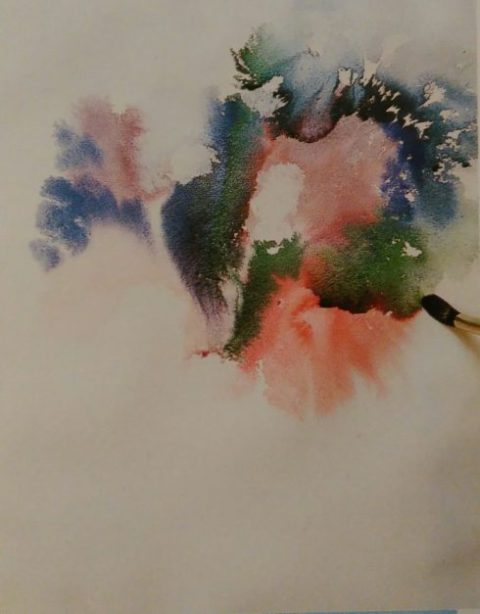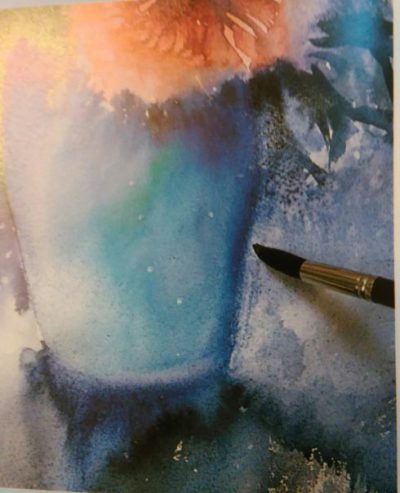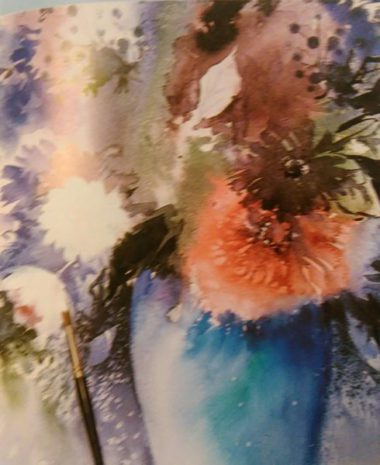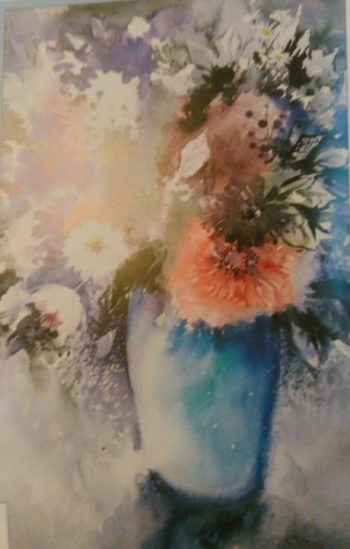Painting wet on wet is one of the most beautiful and one of the most expressive techniques in watercolour painting. When colours are applied on to the wet or moist surface they gently penetrate into one another and dry keeping the mild foggy quality. This technique is most effective when painting the sky or the water because you create a mild gradation of tone thus expressing the flickery nature of light.
Also when you are painting delicate objects like flowers technique wet on wet allows you to mix colours on the paper in a natural way without leaving the sharp edges.
Preparation
For this technique, it is best to use heavier paper 410gr per square meter or more which can withstand a large amount of water and colour without wrinkling. Moist paper with water using a
Lean the board with the paper at an angle so the colour can slide down gently. Leaving the board flat on the desk while you are painting can cause the added paint to make unwanted traces and smears.
Painting with watercolours wet on wet requires confidence because you can control the paint only to a certain point. Wide brushes are the best for this technique because they allow you to apply large amounts of paint with wide long strokes. Use a wet brush and work fast and relaxed letting the colours to spread naturally.
The biggest mistake you can make while painting wet on wet is to use too much water with your colours, that will only make your painting look fake and uninteresting. Since the paper is already moist you can use almost undiluted colour. The colour will get softer on the paper but it will preserve its

Flowers in a blue vase
For this painting, you will need the following:
- One sheet of watercolour paper primmed on to a wooden board weighing 285 grams per square meter
- Round Sable bristle brush number 16
- Round Sable bristle brush number 5
- A straw
- Kitchen salt
And following watercolours:
- Indigo
- French Ultramarine
- Alizarin Red
- Windsor Blue
- Windsor Green
- Fishermans Dark Green
- Cadmium Yellow
- White

Leen the drawing board at an angle and then apply clean water on the entire surface of the paper using round Sable bristle brush number 16. Using the same brush, working quickly, apply separate paint drops to point out flowers. Paint the purple-blue flowers with Indigo, dark purple with Alizarin Red mixed with a bit of Indigo and pink flowers with diluted Alizarin Red.
Mix French Ultramarine with Indigo for areas of blue background and for leaves use Fishermans Dark Green mixed with Indigo. The paint will spread on the wet surface leaving white areas of paper visible underneath thus creating small white flowers.
Work quickly on your painting adding spots of Ultramarine, Alizarin or indigo surrounding the shapes of white flowers. The speed is very important, the paper must remain wet in order for the paint to spread.
Do not try to paint the flowers realistically let your imagination and intuition guide you. Use the tip of the brush to paint shapes of flowers and petals. Paint around the vase with diluted French Ultramarine to point out its shape.


Paint the background with a darker colour to point out your composition. Use different combinations of Indigo, Windsor Blue and Ultramarine. Mix Windsor Blue and Indigo to paint the tones around the vase. With the same more saturated mixture paint the shade vase is creating on the table to create the appearance of the vase standing on the table.
Spread a little bit of salt on the wet paint leaving it to dry for ten minutes. This will give your painting fine texture and create small white flowers on your painting.
Use the brush to add some water to a big pink flower and add a drop of Alizarin Red and a bit of indigo to point out the tone contrast. Paint the petals with the tip of the brush and add light areas using salt on the edges. Let it dry and then mix Alizarin and some Indigo and add several darker flowers and leaves to create contrast.
Create strong Aquamarine by mixing Windsor Blue and Windsor Green and paint the vase letting the colour fade near the edges. Paint the shade on the right side using Ultramarine and Indigo and let the colour blend into the Aquamarine creating the round shape of the vase. Use the same mixture to add some colour to the shade on the table.


With the mixture of Windsor Green, Windsor Blue and Indigo paint the leaves on the left side using wide relaxed strokes. Using the same mixture add some berries with the tip of your finger and then use the straw to paint dried stems by simply pulling the straw from the paint downwards.
To paint the dark centre of the flowers in the front plane
Ad some sharp strokes on the flowers in the front plane to point them out even more. Mix Alizarine and a bit of Indigo to paint the centre of the bigger flowers using the tip of the brush. In the end, paint the thin lines on the leaves using diluted Indigo.
This is one way of painting wet on wet using watercolours. If you have any questions and need any help concerning this subject feel free to leave them below and I will be more then happy to help.





0 Comments